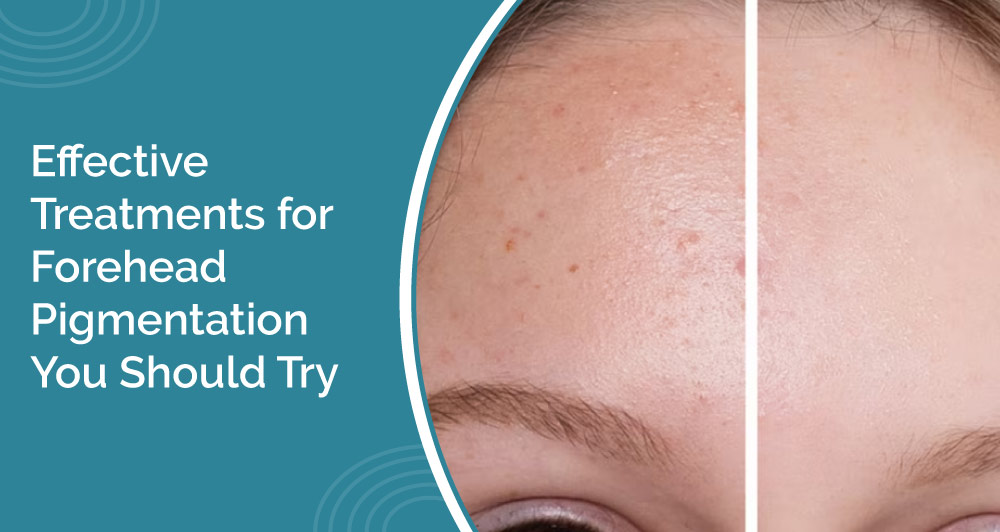May 24, 2025
Forehead pigmentation is a common skin issue affecting a wide range of people in India. They look like dark spots or patches on your forehead, and some can cover your entire forehead. While it is not harmful to your skin, it can make your skin tone look uneven.
If you too are experiencing it, there is no need to worry. There are a lot of treatment options available at our skin clinic in Vile Parle. But first, you must know the types of pigmentation and their causes. We will also cover the procedures on how to treat pigmentation on the forehead.
This blog aims to instil a complete understanding of forehead pigmentation, including causes, treatments, prevention, and when to seek professional help.
A] Understanding Forehead Pigmentation and Its Types
Forehead pigmentation causes the skin to develop dark spots and patches. This is caused by the excess production of melanin, which may be triggered by several internal and external factors. Forehead pigmentation can manifest itself in several forms, such as:
- Melasma: Melasma causes large patches of darkened skin on the forehead and the face. It is often caused by hormonal changes during pregnancy or in women on birth control.
- Sunspots (Solar Lentigines): Sunspots are flat brown or grey spots on the forehead caused by excessive sun exposure. They are very common in older adults.
- Post-Inflammatory Hyperpigmentation (PIH): Dark spots seen after a skin infection or inflammation are called PIH. These can manifest after acne, burns, or eczema.
- Freckles (Ephelides): Freckles are a type of sunspot caused by a combination of genetics and sun exposure. They are more common and noticeable in people with lighter skin.
- Lichen Planus Pigmentosus (LPP): LPP is a chronic condition that causes dark brown patches on the forehead, face, and neck.
B] Most Common Forehead Hyperpigmentation Causes
- Sun exposure increases melanin production, causing uneven skin tone, patches, and dark spots.
- Hormonal changes during pregnancy, menopause, or birth control medication can increase melanin production and trigger melasma.
- Post-inflammatory hyperpigmentation (PIH) is caused by the marks left after healing skin trauma, including acne, cuts, or rashes.
- Genetics play an important role in determining skin pigmentation. Some people are more likely to be more prone to freckles and melasma due to their genetics.
- Certain medications and treatments, like oral contraceptives, anti-seizure medications, and chemotherapy, can cause pigmentation as a side effect.
- Skin conditions like eczema, psoriasis, and LPP are some of the most common causes of forehead pigmentation.
- Improper skincare practices like using harsh products or excessive exfoliation can damage the skin barrier and increase pigmentation.
C] Treatment Options for Forehead Pigmentation
1. Prescription Creams
Mild spotting and patches often do not need extensive treatment. Prescription creams do not have any side effects and are inexpensive. Hence, at our skin clinic in Mumbai, prescription creams are the first treatment offered for pigmentations. They are particularly effective for melasma, PIH, and sun-induced pigmentation. While the results may take a few weeks to be visible, it is best to be consistent.
2. Laser Treatments
Laser treatments use hyperfocused beams of light that target dark spots and melanin. The melanin absorbs these beams of light and gets broken down into smaller particles. These particles are removed from the body by your natural immune system. At our clinic, we use IPL therapy for treating melasma and a host of other skin issues. You may experience mild swelling and redness for a few hours after the procedure, but it will go away without any issue.
3. Microdermabrasion
Microdermabrasion is a non-invasive procedure that uses a handheld device to remove the outer layer of the skin. It is a medical exfoliation technique used to give the skin a smoother texture and even tone. It also promotes cell turnover, allowing fresh, healthy skin to surface. However, it is not effective for deeper pigmentation like melasma or LPP. You may also need multiple sessions to get the best results. The procedure has minimal downtime and side effects, making it a popular choice.
4. Chemical Peels
As the name suggests, chemical peel treatment uses chemicals to peel the top layer of the skin. It is a safe and effective treatment for removing pigmentation. The strength of the chemicals used also varies depending on the type of chemical peel recommended. Chemical peels are of three types: mild, medium, and deep chemical peels. For removing pigmentation, you may require either a mild or medium chemical peel, depending on your individual needs. You may need multiple sessions for long-lasting results. While you can find at-home chemical peel kits, you should always seek a professional, as it can be extremely risky.
Also Read: Top Benefits of Chemical Peel Treatment To Transform Your Skin
D] Prevention of Forehead Pigmentation
- Daily Sun Protection: Use a broad-spectrum sunscreen with SPF 30 or higher every day. Reapply every 2–3 hours, especially if outdoors.
- Consistent Skincare Routine: Use gentle cleansers, hydrating serums, and products with ingredients like vitamin C and niacinamide. Avoid harsh scrubs and alcohol-based toners.
- Manage Hormonal Triggers: If pigmentation is linked to hormonal changes, consult a dermatologist immediately. Hormone therapy or changes in medication may help.
- Avoid Picking or Scratching Skin: Touching acne or rashes can lead to PIH. Keep your hands off your face and treat skin issues promptly.
- Regular Dermatologist Visits: A dermatologist can diagnose conditions at an early stage and suggest how to prevent skin pigmentation. Hence, regular visits to your dermatologist are recommended.
E] When to See a Dermatologist?
If you notice forehead pigmentations spreading, darkening, or not improving with OTC creams, you should consult a dermatologist at the earliest. If the pigmentation appears suddenly during periods of hormonal changes like menopause or pregnancy, professional evaluation becomes necessary. We will not only accurately diagnose your condition but also suggest effective skin pigmentation treatment in Mumbai tailored to your skin type. Delaying medical advice may lead to deeper pigmentation and longer recovery.

